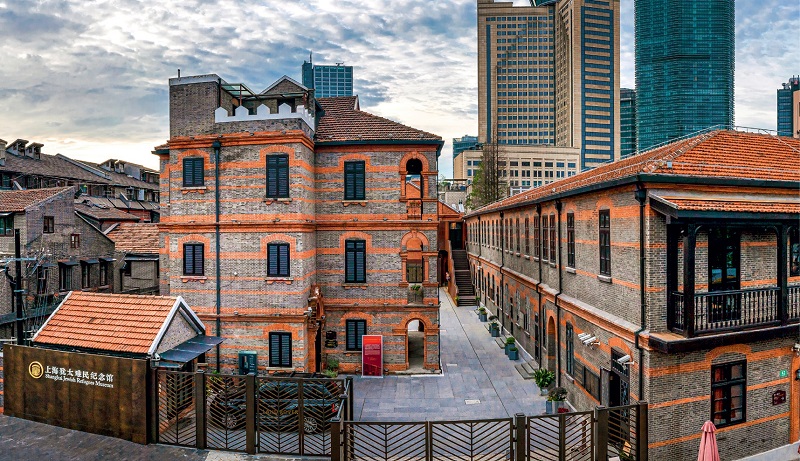
An aerial view of the Shanghai Jewish Refugees Museum. Wan Niansong
In the Shanghai Jewish Refugees Museum, a beautiful handbag is waiting for its owner in a display cabinet. The handbag belongs to a Jewish couple. When they sought refuge in Shanghai during World War II, they pawned the handbag to Jin Wenzhen’s grandfather in exchange for their child’s medical expenses. He lent the couple the cash equivalent of one month’s revenue from his rice shop, but then never saw them again.
Jin’s grandfather remained concerned about what happened to the Jewish family. He handed the handbag to his granddaughter and told her that it was a family heirloom and must be well kept. As Jin grew older, her desire to find the owner of the handbag became stronger. She took it to the Shanghai Jewish Refugees Museum, where she hoped it could be displayed and somehow a search for the descendants of the Jewish owner could be carried out. The search continues.
The museum, covering an area of over 4,000 square meters, houses nearly 1,000 historical items that tell more than 160 personal stories, recording the life of Jewish refugees and their interactions with local residents in Shanghai during World War II.
Established in 2007, at the former site of the Moses Synagogue, the museum is the only memorial hall in China that reflects Jewish refugees’ lives during World War II. The Moses Synagogue was built in 1927 and was the main gathering place for Jewish refugees at that time. It is also one of the two remaining synagogues in Shanghai.
In the museum’s courtyard, the Wall of Names of Jewish Refugees in Shanghai is engraved with 18,578 names. Over the years, it has attracted many former Jewish refugees and their descendants to search for the names of their family and friends.
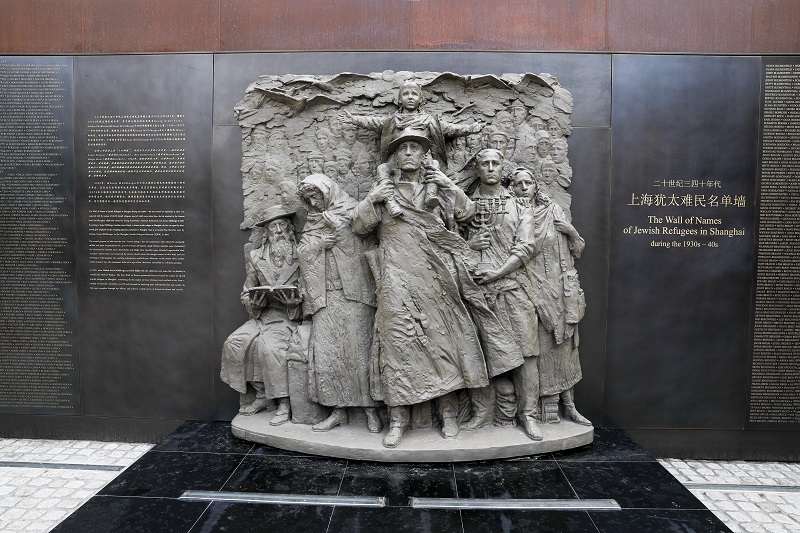
The Wall of Names of Jewish Refugees in Shanghai. Ding Wenqi
Brief History of Jewish Refugees in Shanghai
During the 1930s and 1940s, a large number of Jews were forced to flee Europe from Nazi persecution. With the help of He Fengshan, then Chinese Consul General in Vienna, and diplomats from other countries, Shanghai became a safe haven for about 20,000 European Jewish refugees from 1938 to 1941.
The majority of Jewish refugees arrived in Shanghai without money or friends in the city. However, they always maintained a positive attitude towards life and helped each other when facing difficulties.
Jewish communities and international rescue organizations, such as the International Committee for Granting Relief to European Refugees, the Committee for Assistance to European Jewish Refugees in Shanghai, and the United States Jewish Joint Distribution Committee, also took measures to assist, provide relief to, and resettle Jewish refugees.
Initially, after settling down in Shanghai, many Jewish refugees began to look for local job opportunities. Among them, a small number of doctors opened their own clinics, but the majority could only make a living by running small shops. As the number of Jewish refugees increased, they began to establish their own community administration, and also founded Jewish schools, hospitals, newspapers, and magazines. They also held vocational training, and carried out cultural and sports activities.
After the outbreak of the Pacific War in 1941, the situation in Shanghai changed severely. On February 18, 1943, the Japanese occupiers in Shanghai issued a notice on the establishment of a special residential area for stateless refugees in Hongkou District. From then on, many Jews were forced to give up their homes and jobs and move into the area, which meant harsh living conditions.
Facing difficulties in their lives again, the Jewish refugees continued to create various jobs and institutions with tenacious survival skills to improve their living conditions. They also forged a profound friendship with the local Chinese people in the area through mutual assistance.
After the end of World War II in August 1945, the Shanghai Jews began searching for the whereabouts of their family members. After learning about the tragic experiences of those in concentration camps in Europe, they were very grateful for Shanghai as a refuge, which had saved them from Nazi atrocities. Later, they immigrated to countries such as the United States, Israel, Canada, and Australia.
Although the Jewish refugees left Shanghai, they still feel grateful for the place where they were rescued, and continue to regard Shanghai as their “second hometown.” Their descendants continue to return to Shanghai to search for their roots and remain in contact with the museum.
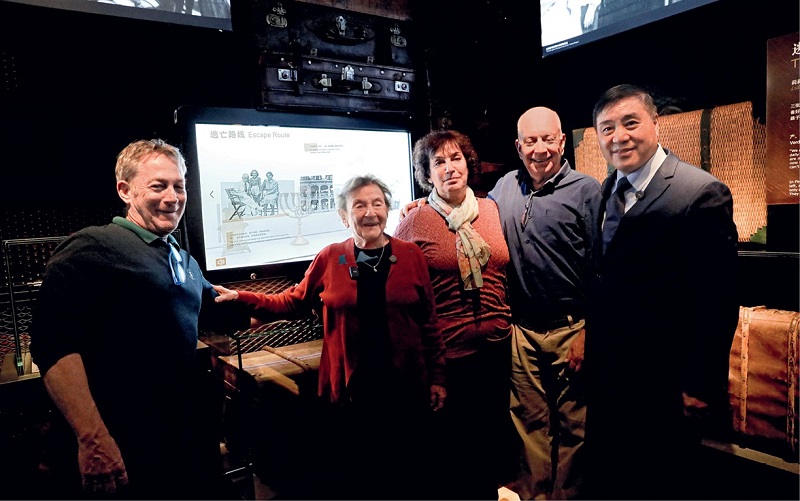
A former Jewish refugee in Shanghai Lilli Fliess (second from left), her three children, and director of the museum Chen Jian (first from right) pose for a group photo in the exhibition hall on November 5, 2024.
Returns to the Memory
Since its establishment, the museum has received over 1.5 million visitors from 137 countries and regions, with about 30 percent of them from abroad. It has also received many foreign politicians and celebrities, including many former Jewish refugees and their descendants.
Ariel Cukierman, chairman of German Suprema Group and a descendant of Jewish refugees, visited the museum on December 21, 2024. Cukierman accompanied his mother Bela Wolff, who had taken refuge in Shanghai, to visit the museum in 2009. At that time, the museum had two small exhibition halls and limited display of relics.
In 2024, he was very impressed by the big changes that had taken place in the museum since its expansion, and admired the great efforts made by the staff in collecting exhibits and unraveling history over the years. He said that during his youth, his mother often told him about her experiences in Shanghai. He felt very familiar with many stories, photos, and artifacts displayed in the museum.
After the visit, Cukierman also showed a documentary of his mother’s 80th birthday. In the video, Wolff tells the story about her childhood. She said that it was not a difficult life as a refugee in Shanghai, and it remained a memorable experience for her.
Cukierman said that his mother’s experience in Shanghai has always given him a special feeling and understanding of China. He has also established cooperative ties with Chinese partners such as Oriental International (Holding) Co., Ltd. (OIH). As a gesture of goodwill, he has since donated his mother’s passport from her refugee days to the museum through OIH.
Lilli Fliess, a former Jewish refugee in Shanghai, returned to Hongkou and relived her memories with her three children on November 5, 2024. Fliess fled to Shanghai with her parents to find refuge in 1939, when she was only 10 years old. In 1948, she left Shanghai and settled in Israel. In 2001, she returned to Shanghai. After more than 20 years, she went back again and visited the museum for the first time.
Fliess visited her old residence in Hongkou and told the staff of the museum about her experiences. She also visited the exhibition in the museum and looked for the names of her family members and friends on the wall of remembrance, which took her five hours. Despite being 95 years old, she insisted on walking during her visit instead of using a wheelchair, to feel again the land where she had once lived.
At the end of her last visit, Fliess expressed her gratitude to Shanghai. She said that she was very lucky to have been there at that time. The city saved the refugees’ lives and she will never forget her home in Shanghai.
She also left her comments in Hebrew, German, and English in the guestbook: “I had lived in Shanghai for eight and a half years, then moved to Israel. I was deeply touched by today’s visit. I returned to Shanghai today and visited my former home in Hongkou. Thank you for the opportunity to visit this impressive place.”
“I have witnessed many former Jewish refugees over 90 years old coming to Hongkou to search for their former homes, and also received the documents related to their refuge in Shanghai that they have kept for decades. I realize that Shanghai is the root and soul that they can never let go of in their hearts,” said Chen Jian, director of the Shanghai Jewish Refugees Museum. “Preserving the history is the long cherished wish and aspiration of the Jewish people. It is an indelible memory of the Jewish nation, and also a period of history that Shanghai cannot forget. For members of this great city, it is our responsibility to record, protect, and inherit the history.”
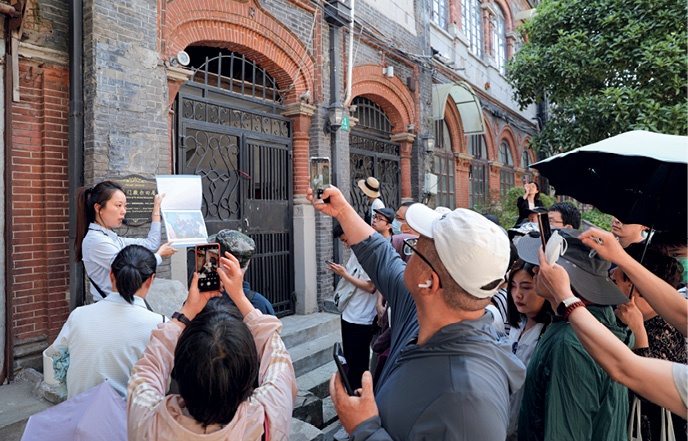
Visitors take photos of the former residence of W. Michael Blumenthal, former U.S. Secretary of the Treasury, during a city walk event organized by the museum.
Cultural Exchange Events
Based on its collection, the museum has presented a themed exhibition on Jewish refugees and Shanghai. Since 2011, the exhibition has been held in more than 10 countries including the United States, Germany, Israel, Australia, and Brazil. It has built a communication platform between China and the official and private sectors of the countries where the exhibition is toured, promoting people from different cultural backgrounds to learn the common history, and enhancing understanding and mutual respect.
In the preparation of the exhibition tour, the museum has connected with local cultural institutions. It has been held in public spaces such as the U.S. Capitol, the Museum for Hamburg History in Germany, and the Budapest History Museum in Hungary, and also collaborated with local cultural centers and museums, making authentic historical narratives for local audiences.
At the opening ceremony of the exhibition at U.S. Capitol in 2014, Cui Tiankai, then Chinese ambassador to the U.S., said that the event would have a profound impact on China-U.S. relations. Six members of the U.S. House of Representatives and then President Obama’s Adviser for Jewish Affairs also delivered speeches. More than 200 staff members at the U.S. Capitol attended. An updated exhibition entitled “Shanghai, Homeland Once Upon a Time” was held at Fosun Plaza in New York in August 2023, receiving attention and positive coverage from over 700 global media outlets including The New York Times.
The 34th Annual Conference of the World Federation of Jewish Holocaust Survivors and Descendants was held in Markham, Canada in September 2024. After the meeting, many attendees mentioned their relatives or friends’ experiences of seeking refuge in Shanghai and expressed their willingness to assist in contacting relevant people. Through the event, the staff of the museum got in touch with 11 people, and interviewed them about the life of Jewish refugees in Shanghai.
In addition to overseas exhibitions, the museum has also organized a series of themed-events in Shanghai, such as citywalks, study tours, and music salons, helping the audience, especially teenagers, understand the history of Shanghai in protecting exiles, learn about the special friendship between the two groups in times of hardship, and showcase the unique charm of Shanghai as a multicultural point of intersection.
To mark the 80th anniversary of the victory in the Chinese People’s War of Resistance Against Japanese Aggression and the World Anti-Fascist War, a special exhibition of the international mutual assistance in the war jointly held by the Nanning Museum and Shanghai Jewish Refugees Museum opened on July 6, 2025 in the Nanning Museum. Through over 100 old photos reflecting individual lives, the exhibition presents international support in the war in Guangxi and Shanghai, to showcase the value of a community with a shared future for humanity.
“The history of Jewish refugees in Shanghai has shocked people with the pain brought by historical disasters, and comforted people with the warmth and light brought to the world by friendly coexistence,” Chen said. “Jerry Moses, a former Jewish refugee, said that kindness, understanding, and tolerance make China great, which war, greed, and hatred can never tarnish. The story [of Jewish refugees] tells people that even in the darkest moments, the goodwill of humanity can still shine. Guarding spiritual heritage is not only a respect for history, but also sows the seeds of future beliefs.”
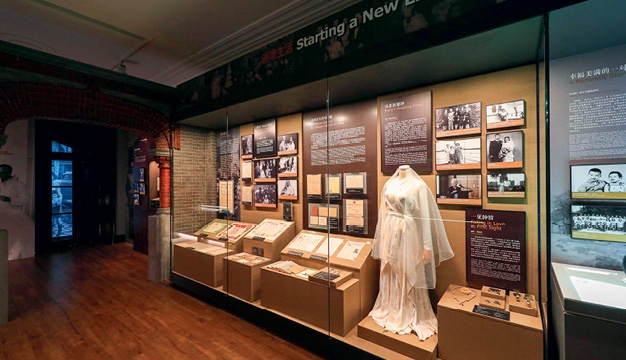
The second part of the exhibition, entitled “Starting a New Life,” in the museum. Photos courtesy of Shanghai Jewish Refugees Museum